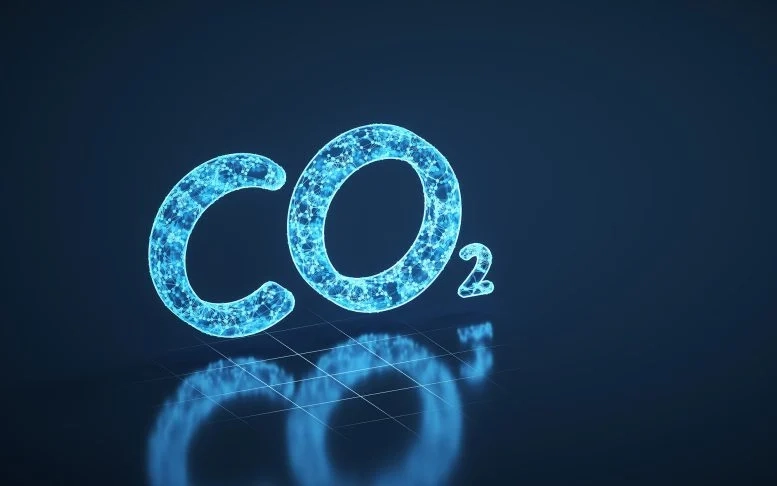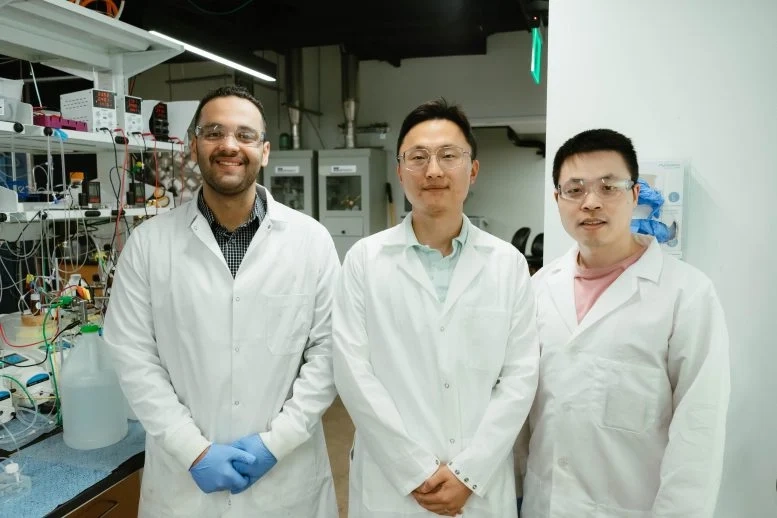 A subtle switch to acid-humidified CO� has unlocked vastly improved stability for CO�-to-fuel systems, revealing a promising path to more durable, scalable carbon conversion technologies. Credit: Shutterstock
A subtle switch to acid-humidified CO� has unlocked vastly improved stability for CO�-to-fuel systems, revealing a promising path to more durable, scalable carbon conversion technologies. Credit: Shutterstock
Acid vapor prevents salt buildup in CO2 reactors, enabling longer, more efficient operation.
A team of researchers at Rice University has found a surprisingly simple way to greatly improve the stability of electrochemical devices that convert carbon dioxide into useful fuels and chemicals: passing the CO2 through an acid bubbler.
Their study, published in Science, tackles a major challenge in CO2 reduction systemssalt buildup in gas flow channels. This buildup reduces efficiency and causes the systems to fail early. By using a method they call acid-humidified CO2 the researchers extended the systems operating life more than 50 times, achieving over 4,500 hours of stable performance in a scaled-up reactora major milestone for the field.
Turning CO� into useful products
Electrochemical CO2 reduction, or CO2RR, is an emerging green technology that uses electricitypreferably from renewable sourcesto convert climate-warming CO2 into valuable products such as carbon monoxide, ethylene, or alcohols. These products can then be refined into fuels or used in industrial applications, offering a way to turn a major pollutant into a useful resource.
Despite its promise, practical use of this technology has been limited by poor system stability. A common problem is the buildup of potassium bicarbonate salts in the gas flow channels. This happens when potassium ions move from the anolyte through the anion exchange membrane to the cathode reaction zone, where they combine with CO2 under high pH conditions.
 From left to right: Ahmad Elgazzar, graduate student in chemical and biomolecular engineering at Rice; Haotian Wang, associate professor of chemical and biomolecular engineering, materials science and nanoengineering and chemistry at Rice; Shaoyun Hao, postdoctoral research associate in chemical and biomolecular engineering at Rice. Credit: Rice University
From left to right: Ahmad Elgazzar, graduate student in chemical and biomolecular engineering at Rice; Haotian Wang, associate professor of chemical and biomolecular engineering, materials science and nanoengineering and chemistry at Rice; Shaoyun Hao, postdoctoral research associate in chemical and biomolecular engineering at Rice. Credit: Rice University
Salt precipitation blocks CO2 transport and floods the gas diffusion electrode, which leads to performance failure, said Haotian Wang, the corresponding author of the study and associate professor of chemical and biomolecular engineering, materials science and nanoengineering and chemistry at Rice. This typically happens within a few hundred hours, which is far from commercial viability.
A simple acid-based solution
To address this issue, the Rice team applied a clever variation on a common technique. Rather than using water to humidify the CO2 gas entering the reactor, they passed the gas through an acid solution, such as hydrochloric, formic, or acetic acid.
The vapor from the acid is carried into the cathode reaction chamber in trace amounts, just enough to alter the local chemistry. Because the salts formed with these acids are much more soluble than potassium bicarbonate, they dont crystallize and block the channels.
The effect was dramatic. In tests using a silver catalyst a common benchmark for converting CO2 to carbon monoxide the system operated stably for over 2,000 hours in a lab-scale device and more than 4,500 hours in a 100-square-centimeter, scaled-up electrolyzer. In contrast, systems using standard water-humidified CO2 failed after about 80 hours because of salt buildup.
Compatible across catalysts and materials
Importantly, the acid-humidified method proved effective across multiple catalyst types, including zinc oxide, copper oxide, and bismuth oxide, all of which are used to target different CO2RR products. The researchers also demonstrated that the method could be scaled without compromising performance with large-scale devices maintaining energy efficiency and avoiding salt blockage over extended periods.
 Haotian Wang, associate professor of chemical and biomolecular engineering, materials science and nanoengineering and chemistry at Rice. Credit: Jeff Fitlow/Rice University
Haotian Wang, associate professor of chemical and biomolecular engineering, materials science and nanoengineering and chemistry at Rice. Credit: Jeff Fitlow/Rice University
They observed minimal corrosion or damage to the anion exchange membranes that are typically sensitive to chloride by keeping the acid concentrations low. The approach was also shown to be compatible with commonly used membranes and materials, reinforcing its potential for integration into existing systems.
To observe salt formation in real time, the team used custom-built reactors with transparent flow plates. Under conventional water humidification, salt crystals began forming within 48 hours. With acid-humidified CO2, however, no significant crystal accumulation was observed even after hundreds of hours, and any small deposits were eventually dissolved and carried out of the system.
Using the traditional method of water-humidified CO2 could lead to salt formation in the cathode gas flow channels, said co-first author Shaoyun Hao, postdoctoral research associate in chemical and biomolecular engineering at Rice. We hypothesized and confirmed that acid vapor could dissolve the salt and convert the low solubility KHCO3 into salt with higher solubility, thus shifting the solubility balance just enough to avoid clogging without affecting catalyst performance.
A breakthrough in durability and adoption
The work opens the door to more durable, scalable CO2 electrolyzers, a critical need if the technology is to be deployed at industrial scales as part of carbon capture and utilization strategies. The simplicity of the approach, involving only small tweaks to existing humidification setups, means it can be adopted without significant redesigns or added costs.
This is a major finding for CO2 electrolysis, said Ahmad Elgazzar, co-first author and graduate student in chemical and biomolecular engineering at Rice. Our method addresses a long-standing obstacle with a low-cost, easily implementable solution. Its a step toward making carbon utilization technologies more commercially viable and more sustainable.
Reference: Acid-humidified CO2 gas input for stable electrochemical CO2 reduction reaction by Shaoyun Hao, Ahmad Elgazzar, Shou-Kun Zhang, Tae-Ung Wi, Feng-Yang Chen, Yuge Feng, Peng Zhu and Haotian Wang, 12 June 2025, Science.
DOI: 10.1126/science.adr3834
This work was supported by the Robert A. Welch Foundation, Rice, the National Science Foundation and the David and Lucile Packard Foundation.
Never miss a breakthrough: Join the SciTechDaily newsletter.



